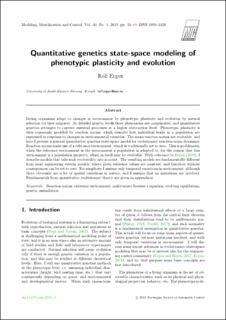| dc.contributor.author | Ergon, Rolf | |
| dc.date.accessioned | 2020-03-23T07:13:08Z | |
| dc.date.available | 2020-03-23T07:13:08Z | |
| dc.date.created | 2020-01-02T10:45:32Z | |
| dc.date.issued | 2019 | |
| dc.identifier.citation | Modeling, Identification and Control. 2019, 40 (1), 51-69. | en_US |
| dc.identifier.issn | 0332-7353 | |
| dc.identifier.uri | https://hdl.handle.net/11250/2647980 | |
| dc.description.abstract | Living organisms adapt to changes in environment by phenotypic plasticity and evolution by natural selection (or they migrate). At detailed genetic levels these phenomena are complicated, and quantitative genetics attempts to capture essential processes at a higher abstraction level. Phenotypic plasticity is then commonly modeled by reaction norms, which describe how individual traits in a population are expressed in response to changes in environmental variables. The mean reaction norms are evolvable, and here I present a general quantitative genetics state-space model for evolutionary reaction norm dynamics. Reaction norms make use of a reference environment, which is traditionally set to zero. This is problematic when the reference environment is the environment a population is adapted to, for the reason that this environment is a population property, which in itself may be evolvable. With reference to Ergon (2018), I describe models that take such evolvability into account. The resulting models are fundamentally different from most engineering system models, where given reference values are constant, and therefore without consequences can be set to zero. For simplicity I assume only temporal variations in environment, although there obviously are a lot of spatial variations in nature, and I assume that no mutations are involved. Fundamentals from quantitative evolutionary theory are given in appendices. | en_US |
| dc.language.iso | eng | en_US |
| dc.rights | Navngivelse 4.0 Internasjonal | * |
| dc.rights.uri | http://creativecommons.org/licenses/by/4.0/deed.no | * |
| dc.title | Quantitative genetics state-space modeling of phenotypic plasticity and evolution | en_US |
| dc.type | Peer reviewed | en_US |
| dc.type | Journal article | en_US |
| dc.description.version | publishedVersion | en_US |
| dc.source.pagenumber | 51-69 | en_US |
| dc.source.volume | 40 | en_US |
| dc.source.journal | Modeling, Identification and Control | en_US |
| dc.source.issue | 1 | en_US |
| dc.identifier.doi | 10.4173/mic.2019.1.5 | |
| dc.identifier.cristin | 1764993 | |
| cristin.ispublished | true | |
| cristin.fulltext | original | |
| cristin.qualitycode | 1 | |

